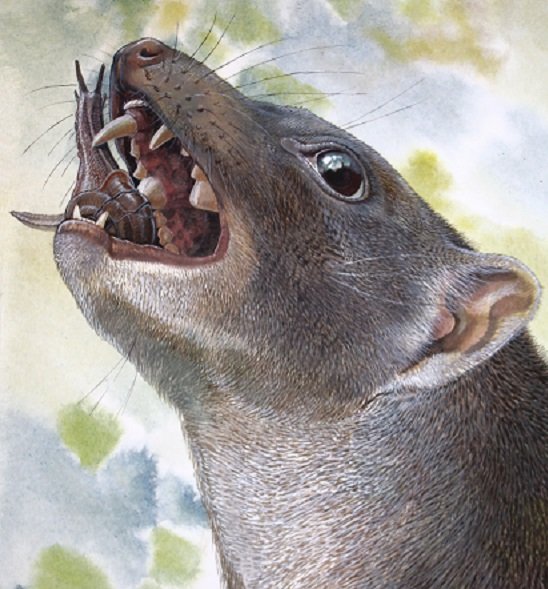Remains of bizarre snail-eating marsupial found

AUSTRALIAN RESEARCHERS have discovered the fossilised remains of a unique family of carnivorous marsupials that lived 15 million years ago.
The fossils of the ancient marsupial, which appears to have had a taste for snails, were unearthed at the Riversleigh World Heritage Fossil Site in north-western Queensland.
“Malleodectes mirabilis was a bizarre mammal, as strange in its own way as a koala or kangaroo,” said Professor Mike Archer, who led the team of researchers from the University of New South Wales (UNSW).
“Uniquely among mammals, it appears to have had an insatiable appetite for escargot – snails in the whole shell,” Mike said. “Its most striking feature was a huge, extremely powerful, hammer-like premolar that would have been able to crack and then crush the strongest snail shells in the forest.”

The upper jawbone of the young malleodectid from the fossil cave at Riversleigh. Because this is a juvenile, the massive premolar is still unerupted below the tooth row. (Image: Karen Black and Suzanne Hand)
Isolated teeth and partial jawbones have been gradually unearthed at the site in Riversleigh where Mike and his colleages have been excavating for almost 40 years. But the profoundly different nature of the marsupials was not realised until a well-preserved portion of the skull of a teething juvenile was recently extracted from its limestone casing, enabling closer study of the remains.
“Details of the canine, premolar and molar teeth of this specimen have enabled its relationships to other Australian marsupials to be determined with reasonable confidence,” said Mike.
“Although it is very different from the others, it appears to have been related to the dasyures – marsupial carnivores such as Tasmanian devils and the extinct Tasmanian tigers that are unique to Australia and New Guinea,” he added.
Fossil-rich ancient cave
The site at which the fossils were discovered is an ancient cave, of which only the fossil-rich limestone floor remains. It contains the bones of thousands of animals that either fell into or lived in the cave.
“The juvenile malleodectid could have been clinging to the back of its mother while she was hunting for snails in the rocks around the cave’s entrance, and may have fallen in and then been unable to climb back out,” said Professor Suzanne Hand, part of the UNSW team behind the discovery, which is described in the journal Scientific Reports.
The researchers believe the family of snail-eating marsupials was likely driven to extinction long before humans arrived by a severe interval of climate change that started 15 million years ago and transformed Australia’s once wide-spread rainforests into more open forests and grasslands.
The UNSW researchers worked on the findings with scientists from Salford University in Manchester and from the University of New England.
READ MORE:
- ‘Big Bird’ ancestor discovered
- Prehistoric platypus with bite
- 15-million year old bilby fossil found
- Tasmanian tiger relative more like a quoll

